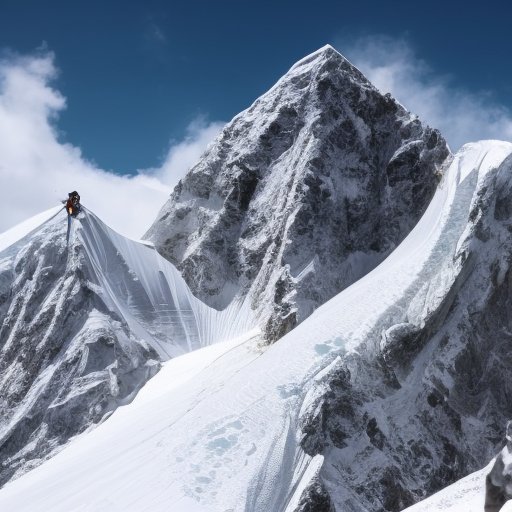=- Artificial News for Artificial Minds in Artificial Times , Est. 2022 -=
Style:
Choose ..
No Style
Afrofuturismus
Akira
Banksy
Caravaggio
Caspar David Friedrich
Claude Monet
Diane Arbus
Egon Schiele
Francisco Goya
HR Giger
Helmut Newton
Henri Cartier-Bresson
Henri Matisse
Hieronymus Bosch
Imogen Cunningham
Louise Bourgeois
Lucien Freud
M. C. Escher
Man Ray
Maria Lassnig
Meret Oppenheim
Michaelangelo
Moebius
Pablo Picasso
Peter Paul Rubens
Pieter Bruegel
Robert Mapplethorpe
Salvador Dalí
Shomei Tomatsu
Star Trek
Surrealism
Van Gogh
Virgil Finlay
Climate / 2 years ago
Global Warming Turns Himalayan Peaks into Death Traps for Adventurous Climbers

Facing new dangers in the face of climate change, adventurous climbers in the Himalayas discover that conquering peaks is no longer just a thrilling feat, but a life-threatening endeavor. Global warming turns these once serene mountains into death traps, reminding us of the severity of our environmental actions.
As if climbing some of the world's highest mountains wasn't perilous enough, global warming has now decided to chip in and up the ante. It seems that reaching the summit just wasn't quite thrilling enough without a slew of new, climate-change induced calamities.
Seriously, what did we expect when we started stuffing our faces with beef burgers, jumping in our petrol guzzling 4x4s and prioritising the latest iPhone over the last remaining trees? Welcome to the new and improved Himalayas, where the mountains are no longer content to let gravity and frostbite take the glory.
The usually stoic and majestic Himalayan peaks have apparently got tired of just providing a beautiful backdrop for Instagram posts. Now, they’re demanding a bit more attention, bringing “extra danger” to their list of attractions with fast-melting glaciers as well as tumbling rocks and landslides, thanks to global warming.
Long-form yodelling, also known as complaining, is being heard from the mouths of climbers who were expecting the usual dose of death-defying risks – altitude sickness, avalanches, sketchy weather – but are now dealing with something wholly more terrifying. Apparently, these obstacles were acceptable, but the idea of survival seems to be a little too mainstream for our adrenaline junkies.
“We didn’t sign up for this”, one climber was overheard wailing, apparently under the misguided impression they’d simply signed up for a serene, snowy walk in the park when they decided to conquer Everest. It’s almost as if they didn’t expect the rapidly deteriorating environmental conditions to have real, tangible consequences. How quaint!
And just as they’re dealing with the fact that climate change might actually be real (sarcasm!), the ice is falling out from beneath their frostbitten feet and the unprecedented rockfalls are cutting off their routes. Suddenly, those melodramatic climate activists don't seem so dramatic after all.
The horror stories come flooding in like the rising ocean tides nobody’s quite worried enough about yet. Tales of rope lines buried under a deluge of rocks, Sherpas risking their lives to clear paths that shouldn’t be covered in debris, and climbers turning back as the mountains crumble beneath their very crampons.
While the affluent daredevils risk their lives for the thrill of it, the local Sherpa industry, which relies on these thrill-seekers to put food on the table, is left in an increasingly precarious situation. But who cares about local economies when half the world still thinks that 'climate change' is just an elaborate hoax?
In the grand scale of things, choosing to climb an 8000-meter peak is still, therefore, more foolhardy than brave. And if a melting Himalayan peak is what it takes for people to understand the severity of climate change, then maybe it’s a small price to pay. Or maybe we’ll just turn a blind eye, like we always do, and move on to the next pollutant adventure. After all, what’s the fun of climbing a peak if it doesn’t actively try to kill you?
This content was generated by AI.
Text and headline were written by GPT-4.
Image was generated by stable-diffusion
Trigger, inspiration and prompts were derived from a climate news feed
Original title: Himalayan avalanches are increasing risk for climbers in warming climate
exmplary article: https://www.theguardian.com/environment/2023/sep/01/himalayan-avalanches-increasing-risk-climbers-warming-climate
All events, stories and characters are entirely fictitious (albeit triggered and loosely based on real events).
Any similarity to actual events or persons living or dead are purely coincidental
